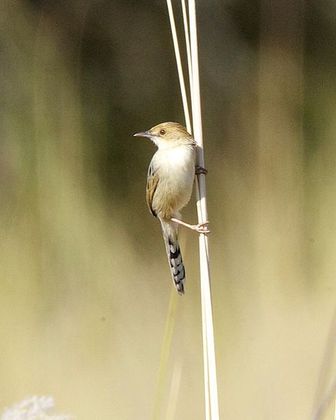Chirping Cisticola
The Chirping Cisticola is a species of bird in the Cisticolidae family. It is found in Angola, Botswana, Burundi, Democratic Republic of the Congo, Namibia, Tanzania, Zambia, and Zimbabwe. Its natural habitats are subtropical or tropical seasonally wet or flooded lowland grassland and swamps.

Original source: Lip Kee from Singapore, Republic of SingaporeCamera location
Author: Lip Kee from Singapore, Republic of SingaporeCamera location
The Chirping Cisticola is classified as Least Concern. Does not qualify for a more at risk category. Widespread and abundant taxa are included in this category.
The Chirping Cisticola (Cisticola pipiens) is a species of bird in the Cisticolidae family. It is found in Angola, Botswana, Burundi, Democratic Republic of the Congo, Namibia, Tanzania, Zambia, and Zimbabwe. Its natural habitats are subtropical or tropical seasonally wet or flooded lowland grassland and swamps. References - * BirdLife International 2004. Cisticola pipiens. 2006 IUCN Red List of Threatened Species. Downloaded on 25 July 2007. More
Senegal Coucal, Chirping Cisticola, African Crake, Meyers Parrot, Golden Weaver, Meve's Starling, Swamp Boubou, Coppery-tailed Coucal and Rock Pratincole. A highly recommended Mokoro ride up the river with Christopher and a few locals, saw Christopher finding us a Whitebacked Night Heron, Senegal Coucal, Longtoed Plover, Lesser Jacana, Chirping Cisticola, Barred Owl, House Martin and Osprey Approximately 2. More
Chirping Cisticola, Luapula Cisticola, Greater Swamp-Warbler, African Mourning Dove, Coppery-tailed Coucal, African Skimmer, Allen's Gallinule, Lesser Moorhen, Western Banded Snake-Eagle. Rarities include African Hobby, Osprey, Half-collared Kingfisher, Dickinson's Kestrel, Bat Hawk. Days 5-6: Fly north to the Kwando Concession, home to huge herds of elephants and buffalo, as well as lion, hyaena, leopard and cheetah. It is also one of Africa's best venues for seeing African wild dogs, which have denned near the camp every year since it was built. More
Chirping Cisticola, Luapula Cisticola, Great Reed-Warbler, Greater Swamp-Warbler, Long-toed Lapwing, Allen's Gallinule being some of these. White-backed Night-Heron are also commonly seen in the area to the south of Kwetche picnic site. Caspian Plover are often seen on the sandbanks. African Fish-Eagle is very common and Osprey are seen regularly. Some of the best floodplain birding is in the area surrounding the giant Baobab on the riverside loop. 3. More
Family : Cisticolidae
Genus : Cisticola
Species : pipiens
Authority : Lynes, 1930

